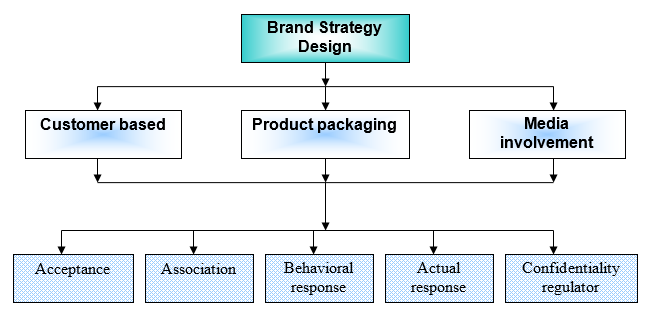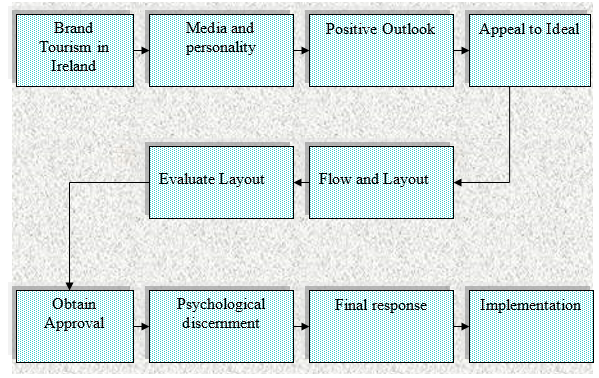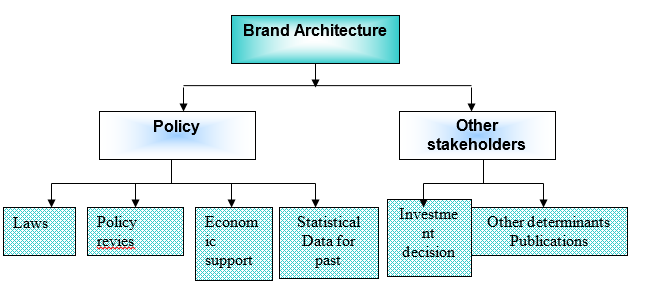Introduction
Ireland is country in Europe continent and is approximately 275 km2. The country is a leader in tourism and friendly investment atmosphere. Over the last six years, the country has faced economic uncertainty and low tourist turn out due to global economic meltdown. Therefore, it is essential to review factors that may play out to save the country from the above dilemma through branding and rebranding of its tourism products.
External factors such as demographic, technological, economic, environmental, and government segments affect the general business environment of Ireland. However, internal factors such as planning, diversification, and competition are essential in brand management of this first world country. Thus, this reflective paper attempts to classify effectiveness of designing and implementing brand strategies in Ireland.
Specifically, the paper reviews the aspects of brand architecture, brand hierarchy, brand strategy design, global brand strategy, and building global customer-based brand equity in brand management of Ireland country as a product. These aspects are reviewed in the various brand slogans and logos used in marketing Ireland to the local and global markets. Generally, the above reflection touches on the tourism industry of Ireland.
Brand and Product Management of the Ireland Tourism Industry
Marketing strategy is essential before actualizing projections of a blue print. As a matter of fact, this plan functions on the margins of informed decision making after comprehensive research on viability and sustainability of a new product or a modified product (Rossiter & Bellman, 2005, p.56). In order to achieve desired margins in sales and total revenues generated, a proper marketing plan should integrate entry strategy, comparative advantage, and market segmentation since in most cases, there is always a strong competitor or competitors that passing might prove challenging due to existence of consumer perceptions and household names (Shimp, 2007, p.13).
Over the last half a decade, Ireland’s tourism industry has experienced downswings due to economic meltdown. As a recovery strategy, the industry had to rebrand in order to successfully restore profitability and confidentiality of its tourism industry (Tourism Ireland Brand Site 2012). Among the adopted branding and rebranding strategies include brand architecture, brand hierarchy, brand strategy design, global brand strategy, and building global customer-based brand equity.
Elements of Brand and Product Management of Ireland’s Tourism Industry
Brand Strategy Design
Tourism industry has kept on making extra special and reliable growth. All together, tourism was perceived with blended outlook by both private and public segments of the business as a self sustaining sector. Together with this in psyche, little endeavour was attempted to present an indispensable provision for its expansion and progress especially after crisis (Belch & Belch, 2009, p.76). In opposition to such background and in vision of its optimistic expansion in addition to future development, there was necessity for a guiding principle for handling crisis, thus, development of a brand strategy design.
Reflectively, this strategy is focused on tackling management programs such as integrity, post crisis policies, media involvement, and destination planning as part of positioning and restoring confidence after the economic meltdown. Among the notable design strategy included online marketing of brand Ireland destination, appointment of global brand ambassadors, and international marketing of the eastern tourism destinations which were adversely affected by the meltdown.
Properly designed brand strategy for product management of Ireland as an ideal tourism destination facilitated the success and sustainability in restoring confidence in the industry by the year 2010. To increase credibility and maintain professionalism, the brand design encompassed processes and features that flawlessly facilitated a healthy and lifetime relationship between the industry and its clients (Tourism Ireland Brand Site 2012).
Among the elements that were integrated in this brand design included brand knowledge, awareness, penetration strategy, passing information to target audience and restoring confidence. The brand strategy was called ‘Welcome to Ireland’ and it had three levels of brand hierarchy, that is, desired awareness created in the discounted rates of travelling, different tourism packages, and simple to understand presentation. These levels were combined to create the simple logo of sandy beach in the back drop of virgin nature. Below this brand is a simple slogan of ‘welcome to Island Ireland, tourism destination’.

In order to attract potential users who are tourists, the brand design strategy narrow down to tourism services and ideal destinations such as the eastern gorges and dotted sandy beaches. This application ensured that accurate information was correctly reflected besides saving time which is of essence to different classes of tourists. The value proportion of this application is capable of tracking past records which have been fed in the computer system on tourists turn out and response on service quality and affordability. In addition, the branding of tourism as a product created direct value for money spent (Belch & Belch, 2009, p.76). As a matter of fact, players in the tourism industry of Ireland have been given the opportunity to customize the application to fit into their data system and fully control flow of information on tourists’ turn over. This is summarized in the diagram below.

Global Customer-Based Brand Equity
Often, emerging businesses demands information flow and dimensional communication systems that is globally accessible. Irrespective of the size and geographical area of operations, brand equity has become an essential part of business operations on the facets and the need for optimal operation. Brand equity has an essential tool for marketing, customer services, and communication from within and without an industry setting, relationship with clients, and market segmentation.
Across the globe, small, medium, and large business organizations have embraced the essence of designing a brand equity from which all its activities are centralized and managed either by a single administrative system or variant systems depending on the sustainability and the cost factor. Different models of brand exist from simple to complex models for larger international companies which aim to cut a niche in the competitive market.
This has been made possible by technological revolution and inventions aimed at remodelling efficiency, reducing redundancy, and embracing systematic orientations in a product. Also, brand equity is an essential aspect of business organization.
Tourism management as an application is essential and may be of ready demand in the hotel environment. The application promises to integrate the older data entry applications and merge them with the sensory and customized application which can go a long way in controlling record keeping and simplify retrieval (Tourism Ireland Brand Site 2012). To enable the industry to be more efficient, there is always a well organized hierarchy of workforce from management with administrative roles to service providing worker.
Managers are empowered by the organization’s constitution to perform the role of prefects and offer leadership solutions upon consultation with one another. Besides these leadership consultants are well picked from the professional job market believed to posses the right and relevant experience in handling group interactions. To control group behaviour, desirable leadership attributes are necessary, which are possessed by the managers gained over time in experience. Management plans, tests and implement company policies in line with the preset goals (Uncles, Dowling, & Hammond 2003). In managing the tourism culture of Ireland, the food and exotic restaurants are branded with friendly logos that suggest peace and comfort.
Environmental analysis is essential in projecting the sustainability and forecasting success of a marketing plan. In this segment, the market is review on the facets of social, economical, technological, and other factors which influence the business environment. Essentials of political operation in the Ireland market have limited influence on business operation due to its stability and policies on economic liberalization.
Ireland is a democratic nation with limited cultural or religious stresses. As a matter of fact, this peaceful group forms the bulwark of the targeted users of local tourism product. This aspect encourages smooth business operations and predictability of the future market trends (Tourism Ireland Brand Site 2012). With the full support of political class to the business community, the overall growth and development of the marketing network is projected as economic policies in operation are inclined towards diversification and promoting business opportunities for investors (Belch & Belch, 2009, p.95).
In addition, the commercial law in Ireland has provision of trademark rights and patent which eliminate fraudulent opportunities to protect such a company from fraudsters and copyright infringers. This is an assurance of protection against illegal trade though the process of registration is time consuming and very expensive. In the long run, this friendly political climate is expected to ease penetration and segmentation of the market. However, with the current economic meltdown, expenditure on food stuff has declined as families tighten budget in response.
Brand Hierarchy
Every industry often perceives that it has conscientiousness to boost the position in which it operates in despite any eventuality. Thus, keeping a positive image among all stakeholders is essential in the Ireland tourism industry especially after the devastating experience of economic depression. Reflectively, the mud mapping plan of this industry has incorporate sustainable communication model and promote amazing endeavour to its customers whose participation in an extensive diversity of courses, services, and image since perception of the industry is viewed in the service quality.
The first step involved carrying out excellent rewards and discount experiences through the finest recognized cruise brands which provide diversity of various living-standards and resources. Through this, the psychological effects were minimised. Reflectively, Uncles, Dowling, & Hammond (2003) viewed that “from workers’ contribution and turn-over donation, services projects to hard cash as well as contribution and inventive charity, the industry can endeavour to impact diversity, both nationwide and globally” (p. 44).
When properly executed, this strategy creates an amazing delight among clients interested in the Ireland cuisine, exotic dishes, and jungle adventure. Besides, construction of enhanced and well-built societies within the industry is necessary for monetary, psychological, compensation and ethical support to customers. Through engaging services of a public relations professional, the crisis was transformed into an interesting sojourn into restoration (Tourism Ireland Brand Site 2012).
Moreover, the brand hierarchy on public relation of Ireland incorporated security and health factors of their customers, tourists, workers as well as all other persons operating on behalf of the business. Thus, the efforts were “focused on the ‘human element’, developing assistance to unemployed tourism workers, ‘saving jobs, re-launching small tourism-related businesses and recovering the visitor flow that makes these economies work” (Tourism Ireland Brand Site 2012).
Definitely, by whole fully abiding by lawful and legislative requirements associated to health, environment, and safety measures incorporated in the social responsibility events, a positive image on issues such as equivalent concern gave the Ireland responsibility of observing and practicing the same on a daily basis (Uncles, Dowling, & Hammond 2003). Basically, brand hierarchy as displayed in Ireland tourism industry as a product is indicated below.

Brand Architecture
Brand architecture should review technological conversancy and lifestyle of targeted customers. Majority of the Ireland population are technology conversant and have embraced new technological was of life. Their lifestyle revolves around technology from transport to communication. Since branding tourism industry as product is technology dependent, it is necessary to establish the estimate statistics on the same.
Research has it that Ireland though populous, has a very high percentage in literary and basic technological skills. Specifically, this rate is higher in youths and young families who the targeted consumers; making this a good business opportunity. In addition, Ireland has better physical infrastructures such as well maintained land transport network to facilitate market accessibility and substantially reduce overhead costs associate with transportation (Belch & Belch, 2009, p.76).
A properly modelled penetration strategy should have minimal disturbances to the market and the company. Therefore, it is important to establish means and ways to reach the potential market. To achieve this, the tourism industry of Ireland have segmented and differentiated Ireland market along consumer-based market segmentation procedures (Uncles, Dowling, & Hammond 2003). This product architecture has incorporated uniqueness in healthy food presentation.
Often this group spends a lot of resources on synthetics products that can be replaced the natural food served in the exotic resorts of Ireland. Therefore, it is important to appreciate comprehensive population patterns for the population across the streets, hotels, motels, collages, and other food outlets as part of the product architecture.
Ireland, tourism industry is subdivided into three distinct segments: the consumer, small and medium business, and institutions segments. This market captures small food outlets, hotels, motels, and retail businesses across the regions of central coast and beyond. Sometimes, quality is compromised due to the volumes of delivery for this market. Ireland tourism management committee intends to introduce cheaper tourism packages in travelling to this market promising diversity in types, lower price, and health with the introduction of cheaper but natural cuisines. Therefore, this segment is influenced by competitive pricing, energy conservation equation, and health value for optimal benefits at a competitive price as key aspects of product architecture (Dawes, 2003, p.9).
The tourism cities of Ireland have several schools, homes, collages, hospitals among other institution with local tourism exchange programs. These institutions are strategically located and uniformly spread across the accessible market of Ireland. Nearly one hundred percept of people found in these institutions are consumers of tourism products such as exotic food, ornaments, and cuisines. With properly drawn partnership and memorandum of understanding, this market is within the influence of Ireland tourism board since its competitors lack this aspect (Richard, 2004, p.65). Also, the competitive pricing will facilitate its sustainability in the highly differentiated market (Castleberry & Ehrenberg1990, p.18).
In the overcrowded market for food products in Ireland, product position is directly linked to the success in the short and long term especially for a new product. In order to achieve the desired goals, positioning ensures clear difference of the new product from the existing products (Gelder 2005, p.23).
Tourism products in Ireland are positioned as the first of its kind in the market. As the only player in tourism regulation, this board is capable of checking excesses of private practices. Once this is achieved, the delivery channel will revolve on quality maintenance to support the leading marketer status (Keller 2003). In the process, a permanent and positive image of the company will be glued in the minds of our clients.
In addition, series of market research on demands of the consumers have been carried periodically to improve on satisfaction, desires, and expand on new market territories (Keller 2003). In the process, focus was directed to the most competitive price and what the customers are able and willing to pay. In order to cut a unique niche, the right audience, who are the locals, have been captivated by the affordability of tourism products. This is summarized in the diagram below.

Global Brand Strategy
In order to diversify market operations, Ireland’s tourism board has created multiple products from the same product with different coloration, sizes, and packaging (Harrison & St. John, 2010, p.68). As a result, this created an environment of own competition and block other competitors from encroaching into this expansive market (Keranen & Salminen 2012. p. 416). These sub-products were differentiated by features, prices, and difference in quality.
As forecasted in the market research, this strategy was successful towards dominance as it offers variety of options to consumers, while at the same time, maximizing benefits of economies of scale at local and international levels (Belch & Belch, 2009, p.45). The high and the low end varieties successfully targeted high and low income earning consumers. With the high end and low end varieties in the market, little room is available for private competitors to create a third product based on quality (Parente 2006).
Tourism as product targets every person irrespective of the economic arms. In order to achieve this aim, demographic differentiation were based on income supported by strategic packaging and series of relevant marketing campaigns. Since Ireland’s tourism board has established itself in the market, they command a price premium (Hakala, Svensson, & Vincze 2012). As a result, the fair pricing mechanism among other factors has skew competitive advantage positively.
In addition, the board has recruited distribution agencies across the regions of Ireland and well trained marketers for these products. Moreover, the company has allocated a semi-annual budget of three million dollars on advertisement and periodic promotions. In order to remain relevant to the ever changing trends in the market, ten percent of projected revenues are pumped back into research and product modification as dictated by demand and supply equations (Richard 2004).
The long term conceptual map for brand globalization management is to roll the application out to other regions and make sales to a tune of over six times the current projections (Rossiter & Bellman 2005). Since the product is self selling and self explanatory, there will be no need of employing so many sales persons. Inspired by the need for proper data storage and use, the product is likely to win confidence of many customers across the globe that is in the hospitality industry.
Recommendations
Essentially, success of brand and product management depends on proper alignment of a functional idea into creation of flexible, involuntary, and quantifiable measurement of perception among the target audience. Reflectively, this idea should have essential elements that can easily sway the mind, either positively or negatively (Shimp, 2007). Therefore, advertisement is pronounced successful when it creates a reliable, informed, and passionate appeal to perception of the target. In the current twenty first century, communication models are interaction of transaction processes where both sender and receiver have an influence on each other as they interact within the realms of global cultural context.
Technical Communication as a subject has also undergone a lot of metamorphosis due to emerging technology (Shimp, 2007). Since technology and communication models directly influence how businesses are conducted, business models have also taken the same complexity. This aspect is under developed in Ireland tourism industry. Therefore, it is mandatory to carry out structural planning, especially in locating target market and actualizing through execution of preset plans without having to physically interact with the target.
With proper planning, messaging, and market objectivity, comprehensive implementation is achievable at optimal level, especially when the same is appealing to the cognitive behaviour and perception. The main effects advertisement has on minds of people include active salience, cueing, perception, and association to a product or service (Sharp, Riebe, & Dawes 2002). The higher the salience and cueing, the more effects advertisement has on the mental attitude and behaviour. Through organised and well executed advertisement messages, the entire globe is within reach.
Among the key advertising agencies in a post crisis management should concentrate on an accessible media (Shimp, 2007). Thus, the brand and product management plan should internalize the need for uniqueness in display, space, packaging, and prominence to easily woe the mind into concentrating on the services offered by the tourism industry. As a matter of fact, in this sense, advertisement might facilitate balancing of display and actual perception on a product with several alternatives that share same physical presence.
Successful execution of brand and product management solely functions on inclusiveness, creation of quantifiable tracking devises for results, and recreating an informed support team. Generally, these effects are very flexible since the mind is characterized by constant dynamics that may make previous designs irrelevant. As a response strategy, players in this industry should capitalize on endorsements through testimonials from important figures to promote acceptance (Uncles, Dowling, & Hammond 2003). Therefore, when the image of the user as projected in such an advertisement resembles the perceived satisfaction of a customer, such a party would aspire to access the same benefits from use.
Though the government is devoted to promoting governance practice and strategies in the tourism industry, the efforts should extend to investors and various stakeholders’ in a considerate and autonomous way. In addition, sound standards of the governance are significant to acquire and maintenance of shareholders’ expectation in the tourism industry. In fact, governance policies are fundamentals in protecting dignity from other providers, the society in which the corporation serves, civic officials, and general client base (Yan, Myers, & Wang 2012).
Therefore, the government should be supportive in the provision of necessary information on Ireland tourism risk analysis. Risk analysis is essential for mitigation, preparedness, response, and recovery planning. In the process of creating a disaster program analysis, the industry should identify and characterize disasters, evaluate each on frequency and magnitude scale, and estimate overall risk as indicated in the government data as a precautionary strategy. Besides, the government has the ability to determine potential, direct, and indirect social and economic costs, effects, acceptable risk level, and identifies appropriate risk reduction opportunities for the tourism industry (Winchester 2006).
Conclusion
Properly researched brand and product management plan determine the success and sustainability in penetrating a market with a product. To increase credibility and maintain professionalism, product processes and feature should flawlessly facilitate a healthy and lifetime relationship between the company and its clients. A properly designed brand and product management plan should be practical in presenting brand knowledge, awareness, penetration strategy, and passing information to target audience.
In achieving these objectives, the plan should map possible competition, positioning strategy, consumer and market analysis, and geographical region of operation. Generally, these concepts are vital in forecasting and act as a guide towards actualizing a marketing plan blue print as seen in Ireland. However, the plan should be flexible to market dynamics and embrace alterations where necessary.
Reference List
Belch, E., & Belch, M. A 2009, Advertising and promotion: An integrated marketing communications perspective, Mass: McGraw-Hill, Boston.
Castleberry, S., & Ehrenberg, A 1990, “Brand Usage: A Factor in Consumer Beliefs,” Marketing Research Journal, pp. 1-23.
Dawes, J 2003, “Marketing gurus and fads: approach with caution,” World Advertising Research Centre Journal, pp. 15-18.
Gelder, S 2005, Global brand strategy: unlocking branding potential across countries, cultures and markets, Kogan Page, London.
Harrison, J. & St. John, C 2010, Foundations in strategic management, Thomson South-Western: Mason, Ohio.
Keller, K 2003, Strategic Brand Management: Building, Measuring, and Managing Brand Equity, Prentice Hall, Alabama.
Keranen, J & Salminen, R 2012, “Systematic review on B2B branding: research issues and avenues for future research,” Journal of Product & Brand Management, vol. 21 no. 6, pp.404-417.
Hakala, U., Svensson, J., & Vincze, Z 2012, “Consumer-based brand equity and top-of-mind awareness: a cross-country analysis,” Journal of Product & Brand Management, vol. 21 no. 6, pp.439-451.
Parente, D 2006, Advertising campaign strategy: A guide to marketing communication plans, Thomson South-Western: Mason, Ohio.
Richard , J 2004, International e-business marketing. Cengage Learning EMEA.
Rossiter, J. R., & Bellman, S 2005, Marketing communications: Theory and applications, Prentice Hall, Frenchs Forest.
Sharp, B., Riebe, E., & Dawes, J 2002, “A Marketing Economy of Scale-Big Brands Lose less of their Customer Base than Small Brands,” Marketing Bulletin Journal, Vol. 13 No. 1, pp. 1-8.
Shimp, T 2007, Advertising, promotion, and other aspects of integrated marketing communications, Thomson South-Western: Mason, Ohio. Tourism Ireland Brand Site. 2012. Web.
Uncles, M., Dowling, G., & Hammond, K 2003, “Consumer Loyalty and Customer Loyalty Programs,” The Journal of Consumer Marketing, Vol. 20 No. 5, pp. 294-314.
Winchester, M 2006, “Positive and negative brand beliefs and brand defection/uptake,” European Journal of Marketing, Vol. 42 No. 6, pp. 553-570.
Yan, R., Myers,A.,& Wang, J 2012, “Price strategy, information sharing, and firm performance in a market channel with a dominant retailer,” Journal of Product & Brand Management, vol. 21 no. 6, pp.475-485.
